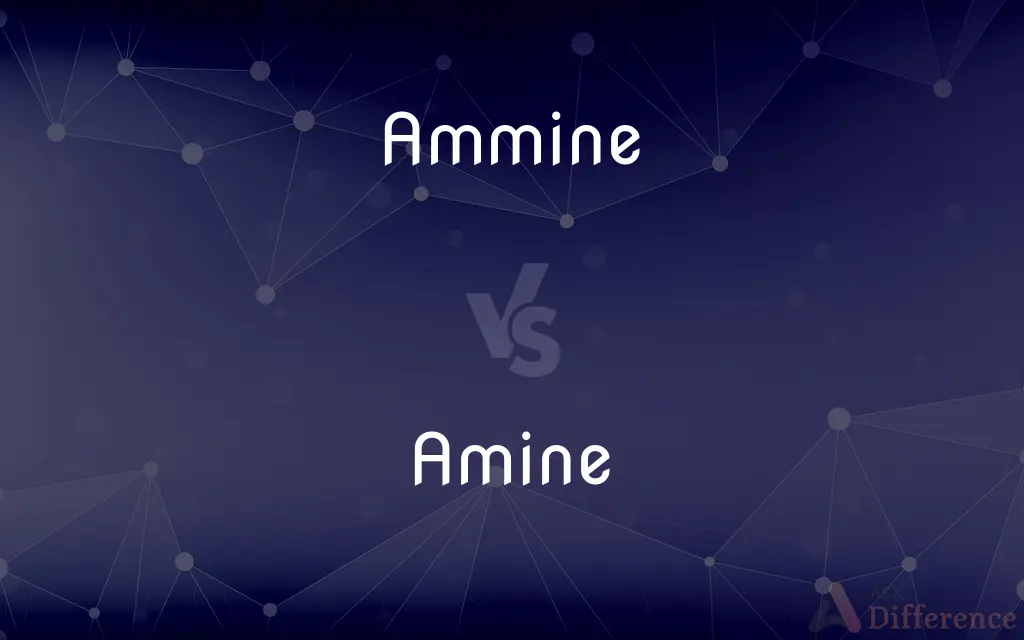Ammine vs. Amine — What's the Difference?
By Fiza Rafique & Maham Liaqat — Updated on March 26, 2024
Ammine involves metal-ligand complexes in coordination chemistry, while amine refers to organic compounds with a nitrogen atom bonded to hydrogen or carbon.

Difference Between Ammine and Amine
Table of Contents
ADVERTISEMENT
Key Differences
Ammine complexes are characterized by the bonding of ammonia molecules to metal ions in coordination compounds. These complexes play crucial roles in various chemical reactions and are essential in fields like catalysis and materials science. On the other hand, amines are organic compounds derived from ammonia by replacing one or more hydrogen atoms with alkyl or aryl groups. They are fundamental in organic chemistry and serve as building blocks for a wide range of substances, including pharmaceuticals, dyes, and polymers.
In ammines, the ammonia acts as a ligand, forming a coordinate covalent bond with the metal ion. This interaction is pivotal in the stability and reactivity of coordination complexes. Amines, however, are characterized by their nitrogen atom's ability to donate a pair of electrons, making them good nucleophiles and bases in chemical reactions.
Ammine complexes often have distinctive geometric structures, influenced by the metal center and the number of ligands attached. These structures are critical in determining the complexes' chemical behavior and reactivity. In contrast, the structure of amines is determined by the alkyl or aryl groups attached to the nitrogen, which can significantly influence their physical and chemical properties.
The solubility of ammines in various solvents can be markedly different from that of amines due to their metal-ligand interactions. Ammines may require specific conditions or solvents to remain stable or soluble. Amines generally have predictable solubility trends based on their molecular size and the nature of their substituents, with smaller amines being soluble in water and larger ones being soluble in organic solvents.
In terms of reactivity, ammines participate in a range of coordination chemistry reactions, such as ligand exchange and redox processes. Amines are versatile reactants in organic synthesis, participating in reactions such as alkylation, acylation, and the formation of amides and imines.
ADVERTISEMENT
Comparison Chart
Definition
Metal-ammonia complexes in coordination chemistry.
Organic compounds with a nitrogen atom bonded to hydrogen or carbon.
Key Components
Metal ions, ammonia molecules as ligands.
Nitrogen atom, alkyl or aryl groups.
Bond Type
Coordinate covalent bonds between metal ions and ammonia.
Covalent bonds between nitrogen and carbon or hydrogen.
Typical Reactions
Ligand exchange, redox processes.
Alkylation, acylation, formation of amides and imines.
Solubility Trends
Depends on metal ion and ligand type.
Predictable based on molecular size and substituents.
Compare with Definitions
Ammine
Characterized by ammonia's role as a neutral ligand in forming complexes.
In [Cu(NH3)4]2+, ammonia acts as a ligand in the ammine complex.
Amine
Found in many biological compounds and pharmaceuticals.
Epinephrine, a hormone and neurotransmitter, is derived from the amino acid tyrosine.
Ammine
Essential in catalysis and materials science due to their unique properties.
Ammine complexes are studied for their catalytic activity.
Amine
Can be classified as primary, secondary, or tertiary.
Dimethylamine is a secondary amine.
Ammine
Involves the coordination chemistry of metals with ammonia.
The synthesis of ammines is crucial in understanding metal-ligand interactions.
Amine
Solubility depends on the balance between hydrophobic and hydrophilic groups.
Ethylamine is soluble in water due to its small size and polar nature.
Ammine
A complex compound where ammonia molecules act as ligands to metal ions.
Hexaamminecobalt(III) chloride is an example of an ammine.
Amine
Organic derivatives of ammonia with one or more hydrogen atoms replaced by alkyl or aryl groups.
Methylamine is a simple amine with one methyl group.
Ammine
Exhibits specific geometric structures based on the metal center.
The structure of ammines can be tetrahedral, square planar, or octahedral.
Amine
Acts as bases and nucleophiles in chemical reactions.
Amines react with acids to form ammonium salts.
Ammine
Any of a class of inorganic coordination compounds of ammonia and a metallic salt.
Amine
In organic chemistry, amines (, UK also ) are compounds and functional groups that contain a basic nitrogen atom with a lone pair. Amines are formally derivatives of ammonia, wherein one or more hydrogen atoms have been replaced by a substituent such as an alkyl or aryl group (these may respectively be called alkylamines and arylamines; amines in which both types of substituent are attached to one nitrogen atom may be called alkylarylamines).
Ammine
(inorganic chemistry) Any of a class of coordination compounds in which ammonia acts as a ligand.
Amine
An organic compound derived from ammonia by replacement of one or more hydrogen atoms by organic groups.
Ammine
A complex inorganic compound that contains ammonia molecules
Amine
Any of a group of organic compounds of nitrogen, such as ethylamine, C2H5NH2, that may be considered ammonia derivatives in which one or more hydrogen atoms have been replaced by a hydrocarbon group.
Amine
(inorganic chemistry) A functional group formally derived from ammonia by replacing one, two or three hydrogen atoms with hydrocarbon or other radicals.
Amine
(organic chemistry) Any organic compound containing an amine functional group.
Amine
One of a class of basic substances derived from ammonia by replacement of one or more hydrogen atoms by an alkyl or aryl group. Compare amide, in which an acyl group is attached to the nitrogen. Hydroxylamine and hydrazine, which are not an organic compounds, are also basic and may also be considered amines.
Amine
A compound derived from ammonia by replacing hydrogen atoms by univalent hydrocarbon radicals
Common Curiosities
What are amines?
Amines are organic compounds derived from ammonia with alkyl or aryl groups replacing one or more hydrogen atoms.
Can ammines and amines be found in nature?
Amines are widely found in biological systems, while ammines are usually synthesized for industrial or research purposes.
How do ammines and amines differ in their bonding?
Ammines involve coordinate covalent bonding between metal ions and ammonia, whereas amines have covalent bonds between nitrogen and carbon or hydrogen.
Are ammines and amines soluble in water?
Solubility varies; amines are generally soluble in water, especially smaller ones, while ammines' solubility depends on the metal and ligands involved.
What is a common use of amines?
Amines are used in pharmaceuticals, dyes, and polymers, highlighting their versatility in organic synthesis.
What are ammines?
Ammines are coordination compounds where ammonia molecules act as ligands to metal ions.
What roles do ammines play in industry?
Ammines are important in catalysis and materials science due to their unique properties and reactions.
What types of reactions do ammines undergo?
Ammines participate in ligand exchange and redox reactions among others in coordination chemistry.
What distinguishes ammines' geometric structures?
Ammines have distinct geometric structures influenced by the metal center and ligand attachment, like tetrahedral or octahedral.
How are amines classified?
Amines are classified as primary, secondary, or tertiary based on the number of carbon-containing groups attached to the nitrogen.
Can ammines act as catalysts?
Yes, ammine complexes can act as catalysts in various chemical reactions due to their unique reactivity.
What types of reactions are amines involved in?
Amines participate in alkylation, acylation, and the formation of amides and imines.
How does the structure of ammines and amines affect their properties?
The structure, determined by metal-ligand or alkyl/aryl groups, significantly affects their chemical behavior and reactivity.
Are amines basic?
Yes, amines are basic due to the nitrogen atom's lone pair of electrons, which can accept a proton.
Share Your Discovery

Previous Comparison
Signaling vs. Signalling
Next Comparison
Doppio vs. SoloAuthor Spotlight
Written by
Fiza RafiqueFiza Rafique is a skilled content writer at AskDifference.com, where she meticulously refines and enhances written pieces. Drawing from her vast editorial expertise, Fiza ensures clarity, accuracy, and precision in every article. Passionate about language, she continually seeks to elevate the quality of content for readers worldwide.
Co-written by
Maham Liaqat















































